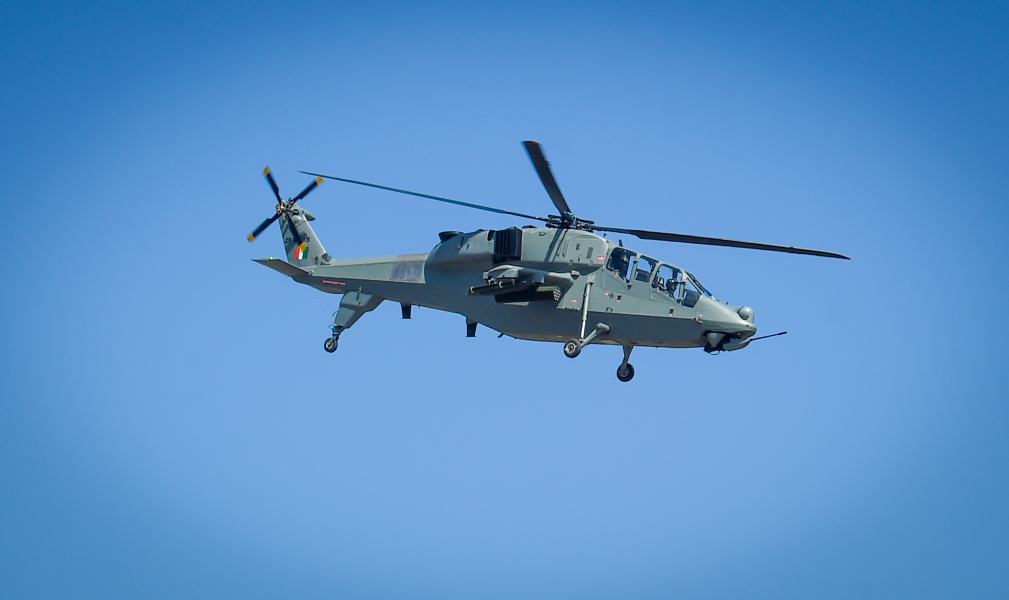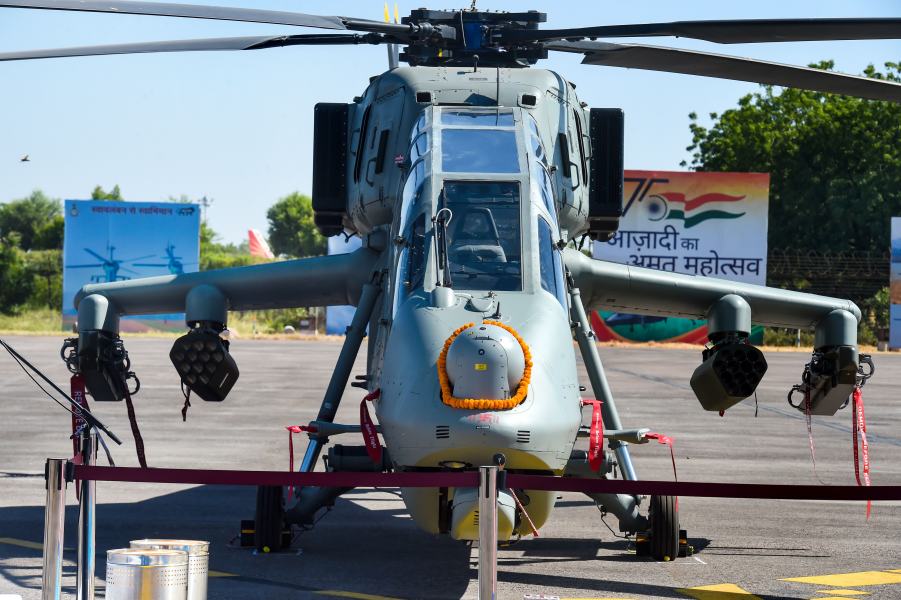
Indigenously built Light Combat Helicopter (LCH) Prachand during its induction ceremony, in Jodhpur, Monday, Oct. 3, 2022. A PTI Photo
JODHPUR (PTI): The Indian Air Force (IAF) has inducted the first fleet of indigenously-built Light Combat Helicopter (LCH) "Prachand", 23 years after the need for such a lethal platform for mountain warfare was felt following the Kargil conflict with Pakistan.
Developed by state-run aerospace major Hindustan Aeronautics Limited (HAL), the 5.8-tonne twin-engine chopper is armed with air-to-air missiles, 20-mm turret guns and rocket systems, and is capable of destroying enemy tanks, bunkers, drones and other assets in high-altitude regions.
The helicopter possesses modern stealth characteristics, robust armour protection and formidable night-attack capability, and is fully capable of even operating in Siachen, the world's highest battlefield.
The fleet comprising four helicopters was inducted into the IAF on Monday at a ceremony at the Jodhpur Air Force Station in the presence of Defence Minister Rajnath Singh, Chief of Defence Staff General Anil Chauhan, Chief of Air Staff Air Chief Marshal V R Chaudhari and other senior military officials.
In a tweet, Prime Minister Narendra Modi said, "The induction of LCH 'Prachanda' is a special moment for the collective resolve of 130 crore Indians to make our nation strong and self-reliant in the defence sector. Congratulations to every Indian!"
The defence minister named the helicopter as "Prachand" (fierce) and said the all-terrain, day-and-night chopper perfectly meets the needs of the armed forces and is among the best in its class globally.
The IAF said the helicopter's name is a "testimony to its lethality and versatility".
The helicopters were given a traditional water-canon salute that followed a multi-religious prayer ceremony and fly-past by Sukhoi jets and Advanced Light Helicopters (ALH).
Singh said the induction of the LCH, with its tremendous power and versatility, not only enhances the combat capabilities of the IAF but is also a big step towards self-reliance in defence production.
"The induction of the LCH underlines the fact that just as the country trusts the Indian Air Force, the IAF equally trusts indigenous equipment. It is a momentous occasion for India's defence production," he said.
The induction of the chopper comes at a time when India and China are locked in a military standoff at certain friction points in eastern Ladakh.
In his address, Singh said adequate attention was not paid to the development of indigenous attack helicopters for a long time after independence.
However, since the Kargil War in 1999, the need for the LCH was felt more and the chopper was a result of two decades of efforts in that direction.
The defence minister later flew a sortie in the chopper, which is designed to deliver a decisive blow to the adversaries on the ground as well as in the air.
A senior IAF official said defeating all the challenges of "hot and high" terrain, the LCH Prachand has demonstrated the capability of operating at an altitude of 6,500 metres with an adequate payload.
Singh said the recent conflicts in Ukraine and elsewhere have shown that heavy weapon systems and platforms, which do not allow for rapid movement in the battlefield, are sometimes vulnerable and become easy targets for the enemy.
Therefore, the need of the hour is to move towards the development of those equipment and platforms, which are mobile, have ease of movement, are more flexible, and at the same time, meet the requirements of the armed forces.
"In this context, the LCH has been developed with an unprecedented balance of all these features and the HAL should be congratulated for this," the minister said.
Singh also praised the role of the IAF in meeting internal as well as external threats to the country since independence and complimented it for reposing confidence in indigenously-developed platforms.
Air Chief Marshal Chaudhari said the LCH adds a unique capability to the IAF's combat potential and the versatility and offensive potential of the platform is on par or better than most attack helicopters operating globally.
He said the selection of the personnel in the 143-helicopter squadron was made on the basis of professional competence so as to ensure the operationalisation of the unit at the earliest.
Managing Director of the HAL, CB Ananthakrishnan, said the helicopter has potent ground attack and aerial combat capability, adding that the need for developing a light combat helicopter for mountain warfare was felt during the Kargil War.
"Subsequently, the IAF and the HAL began exploring the possibility of developing the platform with a capacity to carry an adequate weapon load, sufficient fuel and still be capable of operating in the higher reaches of the Himalayan ranges," said an official.
By mid-2010, the prototype of the LCH completed a major flight test and was deemed to have met the desired parameters.
In February 2020, the LCH was declared ready for production.
In March, the prime minister-led Cabinet Committee on Security (CCS) approved the procurement of 15 indigenously-developed Limited Series Production (LSP) LCH at a cost of Rs 3,887 crore.
The defence ministry had said 10 helicopters would be for the IAF and five for the Indian Army.
The LCH has similarities with Advanced Light Helicopter Dhruv.
The LCH is equipped with the requisite agility, manoeuvrability, extended range, high-altitude performance and all-weather combat capability to perform a range of roles, including combat search and rescue (CSAR), destruction of enemy air defence (DEAD) and counter-insurgency (CI) operations.
The helicopter can also be deployed in counter-insurgency operations in the jungles and urban environments as well as for supporting ground forces.
The helicopter can be used against slow-moving aircraft and remotely-piloted aircraft (RPAs) of adversaries.
Officials said it would be a potent platform to meet the operational requirements of the IAF and the Army.
They said state-of-the-art technologies and systems compatible with stealth features such as reduced visual, aural, radar and IR signatures and crash-worthiness features for better survivability have been integrated into the LCH for deployment in combat roles.
Several key aviation technologies like a glass cockpit and composite airframe structure have been indigenised, they added.
The future series-production version will consist of further modern and indigenous systems, the officials said.
The helicopter has been tested under stringent operating conditions, including at the sea level, in desert regions and in Siachen.
The Army has a plan to acquire 95 LCH largely for a combat role in the mountains.
 Previous Article
Previous Article Next Article
Next Article













The Indian Air Force, in its flight trials evaluation report submitted before the Defence Ministry l..
view articleAn insight into the Medium Multi-Role Combat Aircraft competition...
view articleSky enthusiasts can now spot the International Space Station (ISS) commanded by Indian-American astr..
view article